Lightfoot, Mary, Mrs (McKechnie Section 4)
Recorded by Jackson (The History of Silhouettes). All that is known of Mrs Lightfoot's life is that, from June 1785 until January 1786, John Miers lodged at her house in Castle Street, Liverpool. Two women named Mrs Mary Lightfoot lived in Liverpool at this period: one died in 1837, aged eighty-seven; the other died in 1851, aged seventy-four. The former seems to have been the profilist, since the latter would presumably have lived too late to have had a daughter old enough to have visited Scotland in 1786 as a profilist. See the entry on Miss Mary Lightfoot, Mrs Lighfoot's daughter, who pirated Miers's ideas and attempted to compete with him in Scotland, whose identity has now been revealed from an advertisement published in the Caledonian Mercury by Miers, and who must now be regarded as the pointer of several silhouettes (signed or labelled 'M. Lightfoot') hitherto ascribed to be her mother.
The one known trade label of Mrs Lightfoot is very similar to the label (No. 8) used by Miers during his 'travelling period'. It is also significant that no profiles that can be ascribed to Mrs Lightfoot date from before 1785, when Miers began his eight-month stay at her house. Miers, moreover, is unlikely to have chosen to lodge at the house of an established rival. We can reasonably assume, therefore, that while Miers was staying at her house Mrs Lightfoot was prompted by his example to take up the painting of profiles. I consider it unlikely that she was Miers's pupil, though she probably learned her technique from observation of his work. It is even possible that she may have pirated his ideas, as her daughter had done, and attempted to set up as a profilist, using his methods.
In view of the phrase on her trade label (similar to a phrase on Miers's Trade Label No. 8), 'all orders addressed to Mrs. Lightfoot Liverpool, will be punctually dispatched', it seems likely that she intended to travel outside the city, and may have done so. The backing behind a silhouette in my collection bears a Limerick address, possibly indicating a visit to Ireland. In Woodiwiss' papers there is a note that she was in Abbey Green, Bath, 1787.
That Mrs Lightfoot was still in practice in 1792 is known from the dated profile of Edward Doran (of the Liverpool family) illustrated in Chapter Eight.
234
Later profiles than this may exist, but those which I have examined appear to date from the late 1780s and early 1790s. Many profilists worked for only a short period in this field, and then took up another occupation, and it is possible that Mrs Lightfoot was one of them. In 1792 she would have been aged only forty-two.
Since Mrs Lightfoot probably learned the art of producing profiles by observing Miers at work, she probably produced good likenesses. The quality of her silhouettes, however, is poor. The embellishment of the surround of the main profile on most examples of her work is crude and inartistic, and cannot possibly be compared with the standard achieved by such artists as Miers or Field. Though she did attempt to render the diaphanous veiling much worn by women in her day, the result is coarse. The only detail which she handled with skill was the small bow with tassels which her women sitters wore at the bosom. Sometimes she added a 'shadow line' below the bust-line.
On profiles of men and women alike, front hair is often rendered as a pad-like mass, with little detail. Shirt-frills are also poorly shown with a coarse brush. One example shows a woman wearing a hat with feathers, which, compared with those drawn by Miers or by Thomason, are again not well executed, the bows and tassels being the best part of the work. I have not examined closely any silhouette by Mrs Lightfoot of a woman wearing the à la conseilleur hair-style, much in fashion c. 1787 - c. 1791, but the illustrated silhouette of Mrs Stanley shows a poor rendering of what appears to have been an attempt at this style. Bows on men's pigtails are rendered with an arrow-and-plume formation similar to that seen on Miers's work of the mid-1780s.
It is interesting to compare Mrs Lightfoot's work with that of her daughter. For details of her technique, see the magnification photographs in this Section.
Ills. 234, 1271-1275, 1422, 1430, 1440, 1441
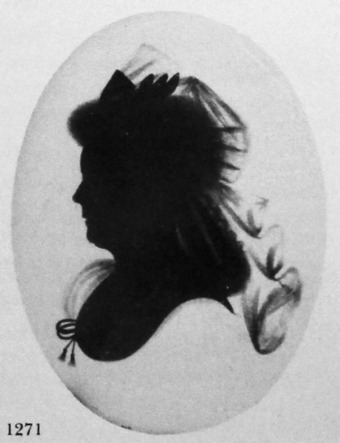
Unknown woman
Silhouette painted on plaster
1786-88
3 ½ x 2 ¾ in./90 x 70mm.
Trade label
Frame: oval, hammered brass
Possibly painted in Limerick.
Author’s collection
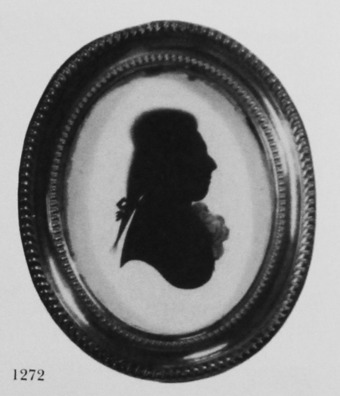
Unknown man
Silhouette painted on plaster
c. 1790
3 ½ x 2 ¾ in./90 x 70mm.
Trade label
Frame: oval, hammered brass
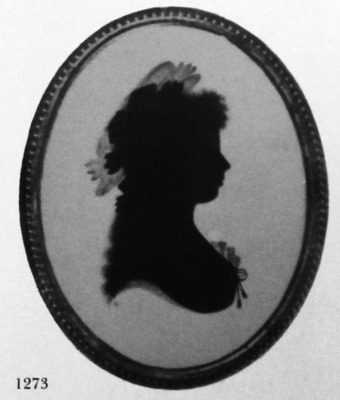
Mrs Stanley
Silhouette painted on plaster
c. 1790
3 ½ x 2 ½ in./90 x 64mm.
Frame: oval, hammered brass
This silhouette shows the artist’s style of rendering the à la conseilleur hair-style.
From Weymer Mills, ‘One Hundred Silhouettes from the Wellesley Collection’ (1912), by courtesy of the Oxford University Press
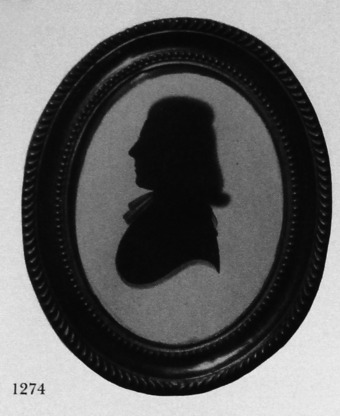
The Reverend James Rouquet, Vicar of West Harpsden, Somerset
Silhouette painted on plaster
3 ½ x 2 ½ in./90 x 64mm.
Frame: oval, hammered brass, with convex glass
Though unlabelled, this silhouette can be ascribed to Mrs Lightfoot on account of the characteristic rendering of the sitter’s hair as well as the shadow line below the bust-line.
P. G. Higgs collection
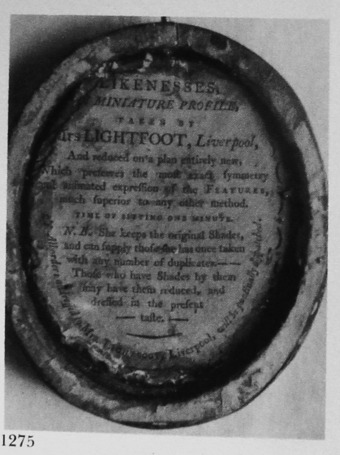
Trade label of Mrs Mary Lightfoot.
Author’s collection
Detail
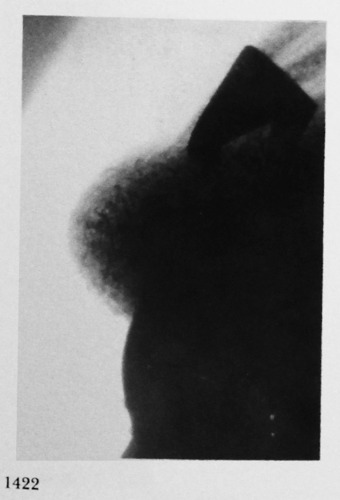
Hair. Detail from a silhouette of a woman by Mrs Mary Lightfoot. The brushwork is much less detailed than that of Samuel Houghton or John Miers. Note the method of rendering a bow normally used by painters on plaster: the bow is arrow-shaped, with a rhomboid cut down from the centre. (1271)
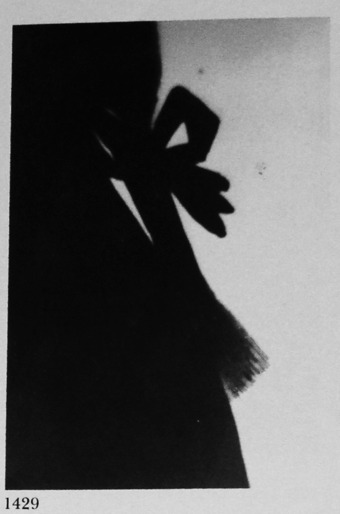
Pigtail wig. Detail from a silhouette of a man by S. Houghton, bearing the label of Houghton and Bruce. (1263)
Crown Copyright. Victoria and Albert Museum, No. P39 1927
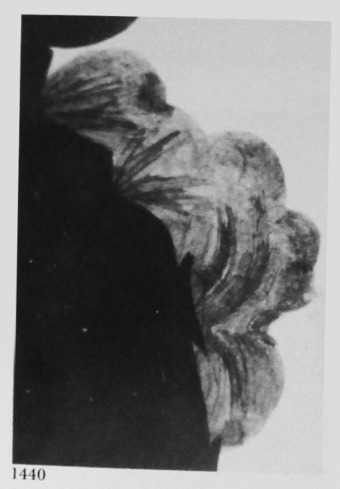
Shirt-frill. Detail from a silhouette of a man by Mrs Mary Lightfoot. The work (probably executed with a coarse brush) is less fine than that of most of the artists discussed in this Section; photographed in magnification, this shirt-frill is not easily recognizable as such. Note the marked concavity of the buttons. (1272)
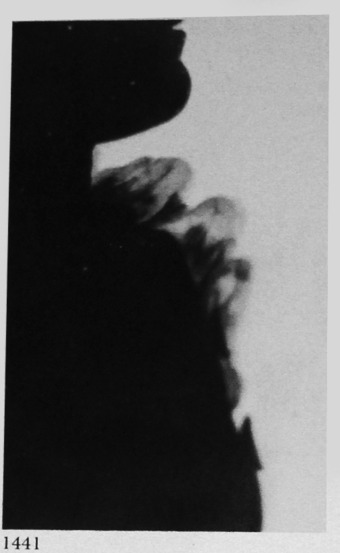
Shirt-frill. This detail from a silhouette of a boy by Mrs Mary Lightfoot shows qualities similar to those visible in 1440. (234)
By courtesy of R. F. Robertson-Glasgow
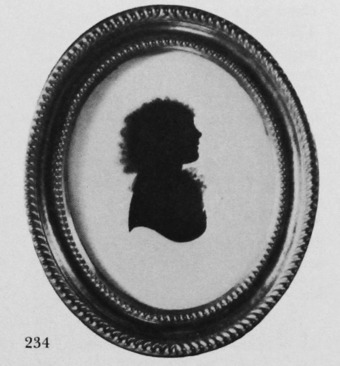
Edward Doran (aged about four), son of Felix and Mary E. Doran (née Foxcroft). Silhouette by Mrs Mary Lightfoot, 1792. (See 241 and 242 for silhouettes of Edward’s sisters.)
costume dating points
Edward’s hair, being curly, is not quite as long as a small boy’s straight hair would have been at the time. The fringe over his forehead is conspicuous.
The position of the shirt-frill (near the neck, and, on this example, visible at the back) shows this to be the silhouette of a boy and not of a girl.
The button on the front of the sitter’s coat or frock indicates his sex.
By courtesy of R. F. Robertson-Glasgow
SECTION FOUR
